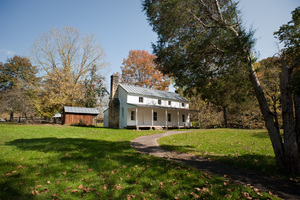 | Back to e-WV
| Back to e-WV
 The West Virginia Encyclopedia
The West Virginia Encyclopedia
 | Back to e-WV
| Back to e-WV
 The West Virginia Encyclopedia
The West Virginia Encyclopedia

Bulltown was named for Captain Bull, a Delaware Indian chief who settled there on the banks of the Little Kanawha River in the summer or fall of 1765 with five families of relatives to escape the warfare afflicting other frontier areas. The Bulltown Indians made salt from nearby salt springs and traded this commodity to settlers of European descent. They remained on friendly terms with European-Americans until 1772, when the Adam Stroud family was killed at the mouth of Strouds Creek, on the nearby Gauley River. While Shawnee from Ohio probably killed the Strouds, local European-American settlers accused the Bulltown Indians and, in retaliation, massacred them. If Captain Bull escaped, he may have been killed in 1781 by other fighters of European descent, or he may have lived until the 1790s.
Bulltown later developed into a local industrial center as a community, with gristmills by the 1820s and prosperous saltworks by the 1830s. Salt was carried to larger towns to be traded or sold. There was a tannery by 1850, using the abundant salt and water. During the Civil War, Union and Confederate troops occupied Bulltown from June 1861 until April 1865 because the Weston & Gauley Bridge Turnpike crossed the Little Kanawha River on a covered bridge at this site. The Battle of Bulltown took place on October 13, 1863. Guerrilla units also fought around Bulltown.
The U.S. Army Corps of Engineers now owns Bulltown as part of its Burnsville Reservoir and manages it as the Bulltown Historic Area.
Written by Barbara J. Howe